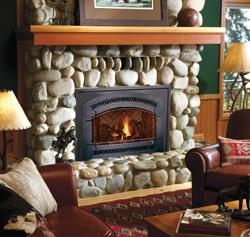In Business Since | License #
In Business Since | License #


Fireplace inserts are designed to install in an existing fireplace and burn either wood, pellets, or gas (shown). Credit: Courtesy of the Hearth, Patio, and Barbecue Association
Many homeowners find that installing a fireplace insert is a smart investment. If you buy an insert that is certified by the Environmental Protection Agency (EPA), you can be confident that you'll be burning cleaner (less pollution) and more efficiently than you can in an open fireplace.
Dr. Energy Saver can discuss the different types of fireplace inserts available to see what best suits your needs. Schedule a home energy audit today to discover how you can save money and live more comfortably!
If you're interested in upgrading your fireplace by installing an insert, you'll have to decide what type of fuel you want to burn. An insert that burns natural gas or propane fuel enables you to turn on a fire instantly. However, gas-fired fireplace inserts are intended primarily to provide the ambiance of a wood fire without the labor involved in storing, splitting, stoking and removing wood ashes. For people interested in saving on heating costs by using a fireplace insert, there are really only two choices: wood-burning inserts and pellet-fired inserts.
Like a pellet stove, a pellet-fuel fireplace insert will burn hotter and cleaner than a wood-burning version. Pellet inserts are designed to operate for extended periods of time, using an automatic power-feed system to supply pellets at a steady rate. With a pellet stove or fireplace insert, a small amount of electricity is required to supply pellets and combustion air and to blow heated air into the immediate living area. Most people find that pellet stoves and inserts are the right choice if you want to use this appliance as a primary heat source for extended periods. For more intermittent use, a wood-burning insert is a better choice.
By using an EPA-certified fireplace insert to provide heat, you can reduce your dependence on fossil fuels and your heating costs. But it's important to also consider other energy-saving improvements, like air sealing and insulation upgrades. Having an energy audit performed on your house will identify where your best energy-saving opportunities are. Trust your local Dr. Energy Saver for your home energy needs!
Looking for a price? Get a no cost, no obligation free estimate.